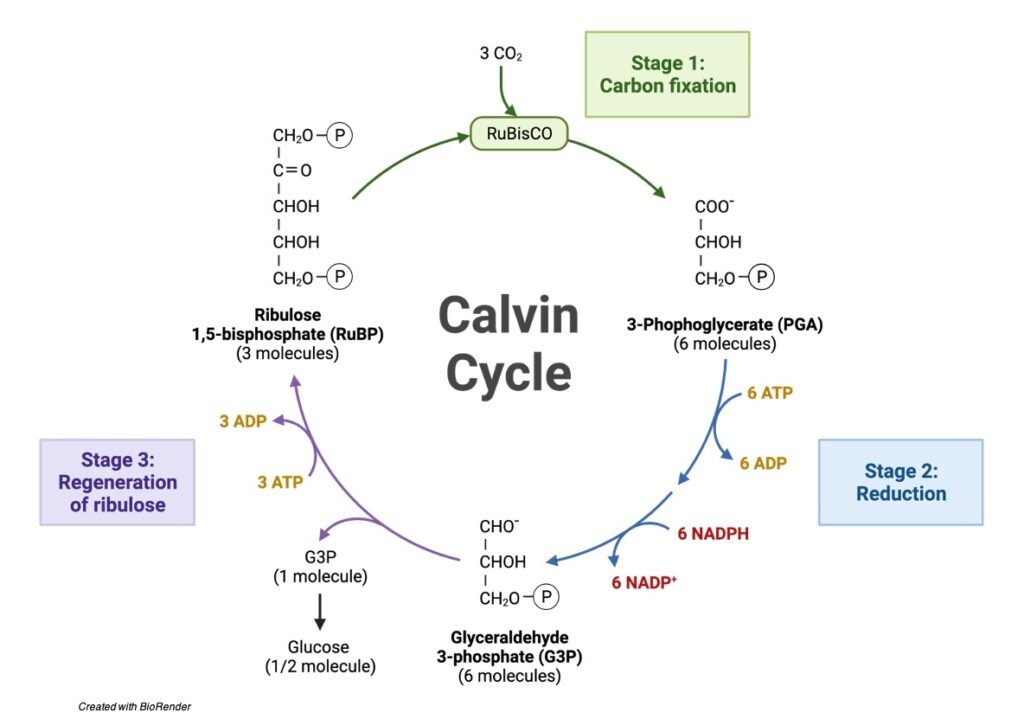Calvin Cycle
Plants are indispensable in world sustaining life forms in earth; producing basic food components from inorganic compounds: CO2, HCO3, etc.
The conversion from inorganic to organic compounds is a light mediated photosynthetic process and a characteristic feature of plants; where they synthesis food using light are called as Autotrophs.
Atmospheric CO2 present as a mixture of gases – Oxygen and Nitrogen; in the stratosphere; formed as a final product of respiration and man.
Carbon is a principle inorganic molecule constituting a skeleton for all organic compounds. One can say that carbon skeleton is basis for all living organism and it circulates from organism to organism then in atmosphere are fixed again in food components by plants enters organism that consumes it.
CO2 fixation is a major process in plants where they utilize atmospheric CO2 to synthesize sugar molecules (i.e.) Starch in the presence of light (photosynthesis).
Starch is stored in plants; plant products are consumed by herbivores and then it enters the food chain involves in structural and physiological functions thereby maintaining homeostasis by participating in various metabolic pathways; as an end product the CO2 is again released to the atmosphere.
Photosynthesis is engrossed in oxygen production and CO2 assimilation at two stages in chloroplasts.
Water oxidation yields oxygen in thylakoid and carbon dioxide reduction to carbohydrates in stroma of chloroplast; powered by ATP and NADPH produced from the oxidation.
Second part of photosynthesis reducing carbon dioxide; is light independent after the enzyme mediating the reaction is activated; called as dark reaction or Calvin Cycle.
Biological CO2 fixation is a significant feature of plants and certain algae and chemoautotrophs.
Alternative Names of Calvin Cycle
Photosynthetic Carbon Reduction Cycle (PCR Cycle), Calvin – Benson Cycle, Reductive Pentose Phosphate Pathway and C3 cycle.
Discovery of Calvin Cycle
Calvin Cycle was discovered by a group of 3 members: Melvin Calvin, Andrew Benson and James Bassham in Berkley deduced the cycle between 1940 to 1953 using C – 14 radioactive isotope which were abundant during the period.
The organism was Chlorella, an algal autotrophic colony. The process is rapid to produce Glyceraldehyde 3 phosphate an inter convertible triose phosphate and regenerates a chemical component taken up in chloroplasts.
Mechanism of Calvin Cycle
Carbon dioxide bio fixation is done in Calvin Cycle in 13 reactions catalyzed by 11 enzymes in stroma. The cycle has 3 phases where the carbon dioxide is reduced and Ribulose – 1, 5 – Bisphosphate is regenerated. Ribulose – 1, 5 – Bisphosphate acts as a primary skeleton to carry CO2 and produce starch.
Three molecules of carbon dioxide are utilized to produce single triose phosphate (i.e.) DHAP.
Phases of Calvin Cycle
The 3 phases are:
(i) Carboxylation: Atmospheric CO2 is fixed by a pentose sugar Ribulose – 1, 5 – Bisphosphate to form 2 molecules of 3 – Phosphoglycerate.
(ii) Reduction: The reaction involves the reduction of 3 – Phosphoglycerate is converted into Hexose sugar molecules when it enters gluconeogenesis.
(iii) Regeneration: The involved Ribulose – 1, 5 – Bisphosphate to regenerate which can be used for many products.

(i) Carboxylation
The initial phase of carbon fixation reaction utilizes carbon dioxide. R – 1, 5 – BP will be attached to Mg+ ion of Ribulose – 1, 5 – Bisphosphate carboxylase/ oxygenase (Rubisco) enzyme and forms an intermediate – Enediolate intermediate, a deprotonated form.
This deprotonated form facilitates CO2 attachment in 4th carbon also, an intermediate of ketoacid. Water molecules enters the reaction to hydrate the pentose intermediate at keto group.
Hydrated pentose sugar yields two 3 – Phosphoglycerate (3 – PGA) molecules. This mechanism is possible when Rubisco containing both carboxylase and oxygenase acts as a carboxylase fixing CO2 to the Pentose sugar.
Three molecules of CO2 react with 3 molecules of R – 1,5 – BP to produce six 3 – PGA molecules.
(ii) Reduction
ATP and Reduced equivalents reduce the C3 carbon to C6 carbon sugars. The reaction converts six 3 – PGA molecules into 6 molecules of Glyceraldehyde – 3 – Phosphate.
Enzyme: 3 – phosphoglycerate kinase and NADP – Glyceraldehyde – 3 – Phosphate Dehydrogenase.
3 – phosphoglycerate kinase catalyzes the conversion of 3 – PGA into 1, 3 – Bisphosphoglycerate by adding a phosphate group from ATP to 1st carbon atom of the molecule.
Similar to gluconeogenetic pathway 1, 3 – Bisphosphoglycerate is converted Glyceraldehyde – 3 Phosphate utilizes reduced equivalent NADPH to form Glyceraldehyde – 3 – Phosphate removing 6 phosphate groups from six molecules of 1, 3 – Bisphosphoglycerate.
The GAP can be transported to cytosol for Carbohydrate compounds in its interconvertible form DHAP.
(iii) Regeneration
Step1: The Primary CO2 fixator molecule yields, a molecule of Hexose sugar which comprises the 3 CO2 molecule absorbed from the atmosphere. The other 5 GAP undergoes further reaction to regenerate 3 Ribulose – 1,5 – Bisphosphate.
Step2: Two molecules of DHAP are formed by the catalyzes of Triose phosphate isomerase. This is the initial step where it forms a reversible DHAP for the formation of Ribulose – 1,5 – Bisphosphate.
Step3: Enzyme Aldolase will condense a molecule of DHAP and GAP to form Fructose – 1,6 – Bisphosphate.
Step4: Fructose 1, 6 – bisphosphatase facilitates the hydration of the F – 1,6 – P to convert to Fructose – 6 – Phosphate.
Step5: the 4th molecule of GAP receives two carbons from F – 6 – P and catalyzed by Transketolase. The product formed is Erythrose – 4 – Phosphate and Xylulose 5 – Phosphate.
Step6: Erythrose – 4 – Phosphate combines with last DHAP molecule to produce 7 Carbon compound Sedoheptulose – 1, 7 – Bisphosphatase mediated by Aldolase.
Step7: Sedoheptulose – 1, 7 – Bisphosphatase is hydrolyzed to form Sedoheptulose – 7 – Phosphate.
Step8: Transketolases transfers two carbon groups of Sedoheptulose to GAP forming Ribose – 5 – Phosphate and Xylulose – 5 – Phosphate.
Step 9 & 10: Xylulose – 5 – phosphate and Ribose – 5 – Phosphate is converted into Ribulose – 5 – Phosphate by the enzymes Ribulose – 5 – Phosphate epimerase and Ribose – 5 – Phosphate isomerase respectively.
Step11: R – 5 – P in the presence of enzyme Phosphoribulokinase converts into 3 molecules of R – 1,5 – BP.
Features of Calvin Cycle
The Calvin Cycle is dependent on few environmental conditions. They are: pH, Mg, NADPH and reduced ferredoxin concentration along with Light.
1. Rubisco enzyme is activated by light. Higher the amount of radiance increased rate of enzyme activity.
2. Light increases the pH level by favoring carbamate formation and Mg
3. Thioredoxin regulates the Calvin cycle by activating enzymes which are used in synthesis of organic compound and degrades the enzymes which inhibit the synthesis.
Calvin Cycle Citations
- Photosynthesis: basics, history and modelling. Ann Bot . 2020 Sep 14;126(4):511-537.
- Kinetic modeling of the Calvin cycle identifies flux control and stable metabolomes in Synechocystis carbon fixation. J Exp Bot . 2019 Feb 5;70(3):973-983.
- Beyond the Calvin cycle: autotrophic carbon fixation in the ocean. Ann Rev Mar Sci . 2011;3:261-89.
- The minimal model of Hahn for the Calvin cycle. Math Biosci Eng . 2019 Mar 15;16(4):2353-2370.
- The importance of the photosynthetic Gibbs effect in the elucidation of the Calvin-Benson-Bassham cycle. Biochem Soc Trans . 2018 Feb 19;46(1):131-140.
- Discovery of the canonical Calvin-Benson cycle. Photosynth Res . 2019 May;140(2):235-252.
Share












